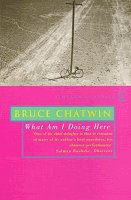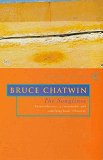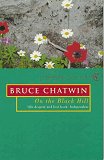
|

 WHAT AM I DOING HERE by Bruce Chatwin (hier online bestellen)
WHAT AM I DOING HERE by Bruce Chatwin (hier online bestellen)
The story:
This is the last of Bruce Chatwin's works to be published while he was still alive (he penned the introduction
in 1988, a few months before he died). It's a collection of Chatwin gems--profiles, essays, and travel stories
that span the world, from trekking in Nepal and sailing down the Volga to working on a film with Werner Herzog
in Ghana and traveling with Indira Gandhi in India. Chatwin excels, as usual, in the finely honed tale.
Here is a journey into the interior of a celebrated novelist and traveler, charged with all of the narrative
power and intellectual challenge of his fiction.
Extract from book:
About the author:
 Bruce (Charles) Chatwin was born on May 13 1940 in Sheffield, England. After a secondary school education at Marlborough College (1953-1957), he went
to work as a porter at Sotheby & Company, the famous London art auction house, where he quickly and amazingly
rose to art auctioneer and director of modern art. He married an American, Elizabeth Chanler, in 1965 and left
Sotheby’s in 1966 to study archaeology at the University of Edinburgh, supporting himself in part by reselling
a private collection of antiquities he had gathered during his career in the world of art auctioneering. Little
interested in a formal educational experience, he concentrated on field
work in Afghanistan and the African Sahara, became fascinated with nomadic peoples and planned to write an
all-encompassing cultural theory of nomadism. While he was unable to bring this project to fruition within the
limiting discourse of scientific anthropology, his idiosyncratic theories and thoughts about nomadic culture
would come to influence his later work as a journalist, essayist, travel writer and novelist. In 1973, on the
recommendation of Francis Wyndham, Chatwin embarked on three years as a journalist for the London Sunday Times
Magazine, a position which enabled him to combine his wanderlust with his growing storytelling impulse.
Bruce (Charles) Chatwin was born on May 13 1940 in Sheffield, England. After a secondary school education at Marlborough College (1953-1957), he went
to work as a porter at Sotheby & Company, the famous London art auction house, where he quickly and amazingly
rose to art auctioneer and director of modern art. He married an American, Elizabeth Chanler, in 1965 and left
Sotheby’s in 1966 to study archaeology at the University of Edinburgh, supporting himself in part by reselling
a private collection of antiquities he had gathered during his career in the world of art auctioneering. Little
interested in a formal educational experience, he concentrated on field
work in Afghanistan and the African Sahara, became fascinated with nomadic peoples and planned to write an
all-encompassing cultural theory of nomadism. While he was unable to bring this project to fruition within the
limiting discourse of scientific anthropology, his idiosyncratic theories and thoughts about nomadic culture
would come to influence his later work as a journalist, essayist, travel writer and novelist. In 1973, on the
recommendation of Francis Wyndham, Chatwin embarked on three years as a journalist for the London Sunday Times
Magazine, a position which enabled him to combine his wanderlust with his growing storytelling impulse.
In 1977, after six months of traveling and writing in the southernmost tip of South America and much negotiating
and revising together with Susannah Clapp, his editor at Jonathan Cape, Chatwin published In Patagonia, an
autobiografictional travelogue. His artful and imaginative interweaving of travel, history, anthropology,
legend, and anecdote won him the Hawthornden Prize (1978) and the E. M. Forster Award (1979), and critics
praised him for reviving the creative styles of D. H. Lawrence, Evelyn Waugh, Graham Greene, and Robert
Byron. Chatwin’s research on the biography of an eighteenth-century Brazilian slave trader in Dahomey,
West Africa, one Francisco Felix da Souza, led to the writing of his second book, The Viceroy of Ouidah (1980).
Chatwin fictionalized the life of da Souza and described his protagonist’s desperate, ruthless, and finally
disastrous career as the Viceroy of Ouidah, a man who held the monopoly over all the slave trade in Dahomey.
Chatwin situated his third book in the English-Welsh border country. On the Black Hill (1982) revives the almost forgotten genre of the pastoral and follows
the lives of identical twins whose experience provides a miniature-like perspective on twentieth-century history
far from the madding crowd, wars, and disasters. The Songlines (1987), his second autobiografictional
travelogue, is based on Chatwin’s several trips to Australia and became his most famous and hotly debated book.
In this text, a narrator, with the revealing name of "Bruce", attempts to decipher and describe for a western
audience the ontology of the Australian Aborigines. The narrative follows "Bruce’s" travels in central
Australia, collecting information about the nomadic Aboriginal "dreaming tracks" from contemporary
Australians as well as the host of literary, scientific, and religious authorities Chatwin compiled
for his anthropological research since the late 1960s. While most western critics hailed the book as
achieving the most desirable postmodernization of the ailing, traditionalist genre of the travelogue,
some Australian readers have chided it as propagating late colonialist views of their country and its
inhabitants. Chatwin’s final longer work of fiction, the novella Utz (1989), is situated in Prague,
that consummate palimpsest of European culture, and recounts the life and obsessions of Kaspar Joachim
Utz, a compulsive collector of Meissen porcelain, who is a captive of his priceless collection in
Communist Czechoslovakia. Two collections of his previously published essays, reviews, and interviews,
What Am I Doing Here (1989) and Anatomy of Restlessness (1996), were published posthumously. In addition
to offering remarkable insights into the lives and works of André Malraux, Ernst Jünger, Konstantin Melnikov,
George Ortiz, Diana Vreeland, Beatrice and Grisha von Rezzori, Axel Munthe, Curzio Malaparte,
to name only a few, they also provide revealing slices of life of the writer himself. Chatwin died of the consequences of acquired immune
deficiency syndrome (AIDS) on January 19 1989, in Nice, France.
Buchdaten:
WHAT AM I DOING HERE by Bruce Chatwin
Sprache: Englisch
Broschiert - 367 Seiten - Vintage
Erscheinungsdatum: 15. Dezember 1998
ISBN: 0099769816
Preis: € 13,95
More works from the same author:
zurück zur Übersicht
|
 WHAT AM I DOING HERE by Bruce Chatwin (hier online bestellen)
WHAT AM I DOING HERE by Bruce Chatwin (hier online bestellen)
 Bruce (Charles) Chatwin was born on May 13 1940 in Sheffield, England. After a secondary school education at Marlborough College (1953-1957), he went
to work as a porter at Sotheby & Company, the famous London art auction house, where he quickly and amazingly
rose to art auctioneer and director of modern art. He married an American, Elizabeth Chanler, in 1965 and left
Sotheby’s in 1966 to study archaeology at the University of Edinburgh, supporting himself in part by reselling
a private collection of antiquities he had gathered during his career in the world of art auctioneering. Little
interested in a formal educational experience, he concentrated on field
work in Afghanistan and the African Sahara, became fascinated with nomadic peoples and planned to write an
all-encompassing cultural theory of nomadism. While he was unable to bring this project to fruition within the
limiting discourse of scientific anthropology, his idiosyncratic theories and thoughts about nomadic culture
would come to influence his later work as a journalist, essayist, travel writer and novelist. In 1973, on the
recommendation of Francis Wyndham, Chatwin embarked on three years as a journalist for the London Sunday Times
Magazine, a position which enabled him to combine his wanderlust with his growing storytelling impulse.
Bruce (Charles) Chatwin was born on May 13 1940 in Sheffield, England. After a secondary school education at Marlborough College (1953-1957), he went
to work as a porter at Sotheby & Company, the famous London art auction house, where he quickly and amazingly
rose to art auctioneer and director of modern art. He married an American, Elizabeth Chanler, in 1965 and left
Sotheby’s in 1966 to study archaeology at the University of Edinburgh, supporting himself in part by reselling
a private collection of antiquities he had gathered during his career in the world of art auctioneering. Little
interested in a formal educational experience, he concentrated on field
work in Afghanistan and the African Sahara, became fascinated with nomadic peoples and planned to write an
all-encompassing cultural theory of nomadism. While he was unable to bring this project to fruition within the
limiting discourse of scientific anthropology, his idiosyncratic theories and thoughts about nomadic culture
would come to influence his later work as a journalist, essayist, travel writer and novelist. In 1973, on the
recommendation of Francis Wyndham, Chatwin embarked on three years as a journalist for the London Sunday Times
Magazine, a position which enabled him to combine his wanderlust with his growing storytelling impulse.



